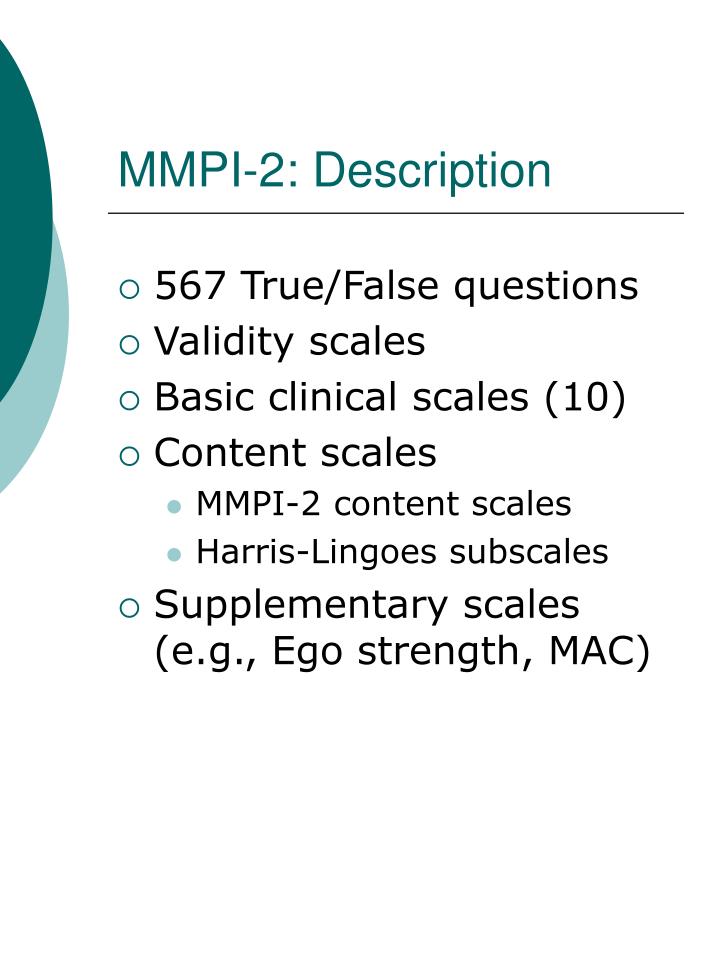
It was necessary to carry out a psychometric analysis of the questionnaire in order to check the reliability, coherence, and internal and external validity of the technique. One of our objectives was to compare the results of the above-mentioned study with those obtained almost 10 years later.

So we were curious to find out what our results in 2009 would be. In particular, one of the most convincing studies was carried out by Shmelev in 2000 (Shmelev, 2002) on a sample of 766 people (students of Moscow colleges and universities). From our point of view, these methods look most suitable for modeling the psychological reality measured by the MMPI. Attempts to apply factor and cluster analyses of MMIL points have been undertaken previously. The question of how test points are structured is also important as features of this structure reflect the psychological reality that the test is expected to measure. Therefore, the relevance of the present research is explained by the necessity of reassessing the psychometric indicators of the MMPI to reflect precisely the actual semantic structures of people surveyed in specific sociocultural conditions. Since the standardization and adaptation of the MMIL there have been significant changes in the political, economic, and spiritual spheres of the Russianspeaking culture these alterations have caused extensive changes in the personal, axiological, semantic, motivational, and behavioral spheres of the Russian people. Petersburg), and Mini-Mult, which consists of 71 statements selected on the basis of factorial analysis, created by Zaytsev and his colleagues (Zaytsev,1981). Bekhterev Psychoneurological Institute in St. Today there is wide circulation of other domestic versions of the questionnaire: the Standardized Method for the Multivariate Study of Personality (SMIL) (Sobchik, 2007), the Standardized Clinical Personal Questionnaire (SKLO) (M. As a result, the MMIL was created (Berezin, Miroshnikov, & Rozhanec, 1976, 1994). Berezin and his colleagues developed an original interpretation of the MMPI scales and carried out a careful standardization and adaptation, taking into account the specifics of sociocultural conditions, the possibilities of applying the test to mentally healthy people, and also the use of the reduced version of the test. The first MMIL version consisted of 384 statements by Berezin & Miroshnikov in 1967.

Butcher et al., 1989).Īdaptation of the questionnaire in our country began in the 1960s. In 1989 the questionnaire was considerably redesigned (the restandardization project began in 1982) and was published under the name MMPI-2 (J. Since then reworked and reduced versions of the questionnaire have been repeatedly offered. The classic version of the MMPI questionnaire was offered by S. The MMPI is a test questionnaire that is extremely popular among not only domestic but also foreign experts. Psychometric analysis, test norms, validity, reliability coherence, representativeness, the Minnesota Multiphasic Personality Questionnaire (MMPI), the MMIL, factor analysis Themes: Psychological assessment Personality psychology Lomonosov Moscow State University, Moscow, Russia That display low variability and that are not significantly correlated with the scale theyīelong to, which reduces their differentiating potential, may be excluded from the test The necessity of readapting the MMIL was thus demonstrated.


(including external validity), the reliability coherence of the scales, and the variability Questionnaire for the normality of the distribution of points and we checked the validity For our update, we constructed linear norms for the test we tested the Such psychometric updating is necessary for maintaining the efficiency Our work on specifying the meaning of the MMIL tasks and, then, on updating the test There have been many essential transformations in thinking and values that have beenĬaused by changes in social and economic reality. Is widely used in various spheres of psychological practice. Version of the Minnesota Multiphasic Personality Inventory (MMPI), the MMIL, which In our research we made a substantial psychometric analysis of the scales of F.


 0 kommentar(er)
0 kommentar(er)
